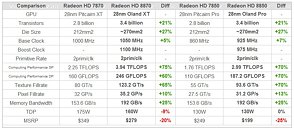Monday, September 17th 2012

AMD "Oland" Radeon HD 8800 Series SKUs Unveiled
Apparently, launch of AMD's Radeon HD 8800 series is close enough for some sources to come up with specifications. The HD 8800 series, according to one source, is based on a new silicon codenamed "Oland," which is built on the 28 nm process, packing 3.4 billion transistors with around 270 mm² die-area. According to the source, the two HD 8800 series models, the HD 8870 "Oland XT" will up performance per Watt and cost-performance ratios over current HD 7800 series, while maintaining current process technologies.
The Radeon HD 8870, according to numbers provided by the source, could offer performance comparable to today's high-end GPUs. The HD 8870 is clocked at 1050 MHz with 1100 MHz PowerTune Boost frequency; while the HD 8850 is clocked at 925 MHz with 975 MHz boost frequency. The memory of both SKUs is clocked at 6.00 GHz, yielding 192 GB/s memory bandwidth. The chips hence have 256-bit wide memory interfaces.Key details such as stream processor, TMU, and ROP counts are excluded, though the source mentions that the HD 8870 provides up to 75% higher single-precision floating point and up to 60% higher double-precision floating point performance over its prdecessor, the HD 7870. The texture fill-rate is up by 65%. The Radeon HD 8850 offers similar increases over its predecessor, the HD 7850. Find them tabled above.
Sources:
Read2ch, VideoCardz
The Radeon HD 8870, according to numbers provided by the source, could offer performance comparable to today's high-end GPUs. The HD 8870 is clocked at 1050 MHz with 1100 MHz PowerTune Boost frequency; while the HD 8850 is clocked at 925 MHz with 975 MHz boost frequency. The memory of both SKUs is clocked at 6.00 GHz, yielding 192 GB/s memory bandwidth. The chips hence have 256-bit wide memory interfaces.Key details such as stream processor, TMU, and ROP counts are excluded, though the source mentions that the HD 8870 provides up to 75% higher single-precision floating point and up to 60% higher double-precision floating point performance over its prdecessor, the HD 7870. The texture fill-rate is up by 65%. The Radeon HD 8850 offers similar increases over its predecessor, the HD 7850. Find them tabled above.

93 Comments on AMD "Oland" Radeon HD 8800 Series SKUs Unveiled
This is the 1st time in 4 generations that AMD is coming out with a complete redesign built from the ground up. It all started with the HD 7900 series. :D
do you think AMD might go all Gk110 on us and not release its big bro for half a year:p
Oh well, look on the bright side....we achieved 44 posts before someone -inevitably it seems- managed to denigrate the graphics IHV that the article wasn't about.
The HD 7970 is based on TSMC's 28nm fabrication process :)
AMD is not going to give away their cards.
7900 series are 28nm, first to come out with 28nm
and dx12 isnt even out yet, and it wont be out until windows 9 or something, windows 8 is still dx11 and it wont be out till october
and 75% over last gen wasnt even achieved with 7900 vs 6900 series even with a new architecture AND a die shrink so calm down dude and lets all be realistic :P
what is more likely to happen is that we will get 7970 levels of performance at lower power envelopes, but max performance for 8970 wont be more that 30-40% over 7970 thats if were optimistic because power/performance doesnt scale linear and the bigger die sizes you make the more conservative you would need to be with clockspeed
so its all a matter of finding the perfect blend of size/clocks for the architecture
think of it like the supply/demand curve for business, there is always a sweet spot
this explains why 7870 is on par or even more efficient than kepler cards, while tahiti is less efficient than kepler(even though it performs better)
They quote the original price for the 7870 at $350, which is now available under $300.
So will the 8870 be even cheaper since it costs 20% less than 7870? :eek:
I guy can dream can't he. :D
If i see the slightest 9xxx Pr blurb id be easy swayed
If AMD plays there cards right and prices the HD 8900's respectfully, they will make killer sales from existing customer along with new. I can see the 8900's prices very well IMO due to being 2nd Generation 28nm.:respect:
I always skip a generation, and now I am ready to buy a HD 8970, if the price is right, that is.
also if you want top of the state grapics, we could give you that but your hardware wil criple from it
When the 8k series hit, I'll be looking to spend ~$300-$350, and if I can't get a 50% increase in performance versus my 5850, then I will hold onto it for another generation, screw it :DWell, I can see me benefitting from a card upgrade as I play BF3 and will be getting Metro:Last Light, which is going to put every system down on their knees. And also, it can't hurt seeing as you have a lot more possibility to max out the AA/AF with SuperSampling which is extremely taxing on just about ALL new games out today.
Apparently untill now the tradeoff was almost always clear: migrating to a new process means more of a performance increase then improving on the arch on the current process.